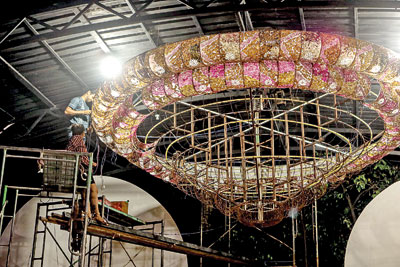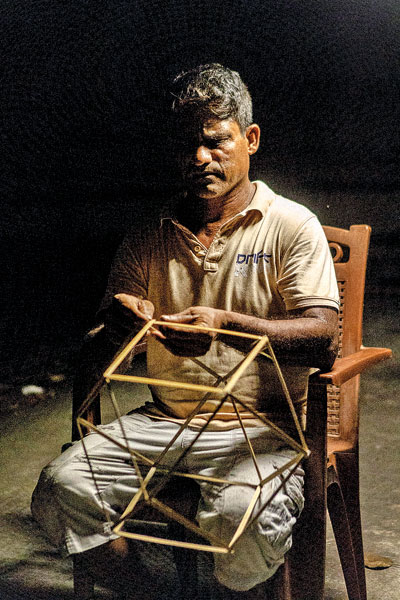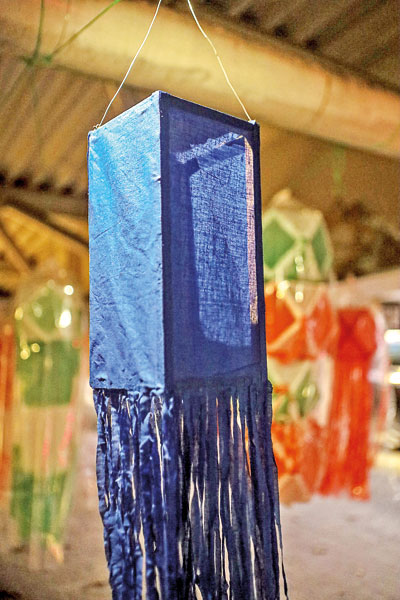Colours of Vesak
View(s):- From the simple kuduwa to more complex ones and the thoran of many bulbs, there is much thought and effort behind the Vesak decor we see on the streets
By Arrenga Nadaraja
Vesak marks the Birth, Enlightenment and Parinibbana of Siddhartha Gautama, the Lord Buddha, and as worship and religious observances in temples take pride of place on Vesak Poya day, families and communities also come together to join in decorating their homes and neighbourhoods with Vesak kudu and thoran that people never get tired of looking at.
In times past, the delicate Vesak kudu were all handmade but in recent years, plastic mass manufactured lanterns are also increasingly being used as the traditional art of making Vesak kudu is fast disappearing. Yet. there are a few who faithfully keep to the practice, some even beginning to make the kudu six months before Vesak, to meet the demand come May.

Complex structure: The unfinished beehive kuduwa
Saman Perera, his wife and three sons, have been making Vesak kudu for the past 10 years. Mr. Perera has made all of 8,020 kudu starting in December 2024, saying with a smile “we start pasting in November.” One of a few families who still take the time and effort to make kudu of different colours and shapes by hand, we find him under the Rajagiriya flyover as traffic streams past.
He took us through the process saying he uses thin sticks of bamboo and strands of wire to tie the sticks together to create the hexagon shape, then covers it with tissue paper purchased from Pettah. His wife and sons help make the kudu, he says adding “my whole house is full of kudu.” His kudu come in a myriad colours – red, pink, blue, yellow, orange, and have interwoven and intricately worked patterns on every one, some with the Buddhist flag on them. He makes the patterns by hand and pastes the paper on the structure with binding gum.

Sticking to the old ways: Saman Perera
The kudu in the nelum mala design, which he had done in pink, takes a long time to make. He explains the technique starting off with making a star shape with the bamboo, then pasting the two stars together. Using a piece of wood to measure the gap of how much he wants the structure to expand to create the flower shape, he finally bends the bamboo to create the petals the way he wants it.
It’s a long process and at the end, “my fingers are ruined,” he says ruefully. The kudu, range from Rs. 300 – 1500. He is happy with the result of his hard work; “Vesak is good for us, we sell kudu and the people who buy from me come every year.”
Viraj Liyanarachi who is a part of the Bakery Space in Pannipitiya has a more modern take on the Vesak kudu. He has been at this for 20 years. This year they plan to make a big kuduwa shaped like a beehive with a digitised projection element (video art) which will depict the life of the Buddha and his enlightenment. There will be live music as well as drama and dance, all coming together in 100 pieces. To cover the kuduwa they use flowers that have been discarded from the temple in an effort to make their work more sustainable. Young students come and help put this together on a volunteer basis.

Old world charm: A simple rectangular kuduwa. Pix by Arrenga Nadaraja
The multi-coloured display of Jathaka katha on thoran, telling of the previous lives of Siddhartha Gautama is the focus of Padmakumara Wijeyabandara, from Avissawella. He has been constructing thoran for about 20 years. His is a family business “learnt from the time we were small’ he says, adding that this skill has been passed down from generation to generation.
He still uses the traditional method of working the thoran, using a large motorised circular revolving cylinder with hundreds of electrical switches activated by a neatly laid out pattern of copper tracks. When one side of the cylinder turns off, the other comes on.
“We do it the old way for people to see how it was done,”he says.
The story illustrated is the ‘Pancha Uda Jathakaya.’ The labour costs and cost of around 50,000 bulbs needed to light the thorana are prohibitive, he says.
Their thoran making doesn’t stop after Vesak, but continues at Poson and Esala, a task done with much dedication for the enjoyment of all.
(Pictured on our Magazine cover is the striking Vesak decor illuminating the Independence roundabout in Colombo)
Searching for that next furry family member but couldn’t find one in your area? Hitad.lk has the solution with our extensive listings of dogs for sale in Sri Lanka!


